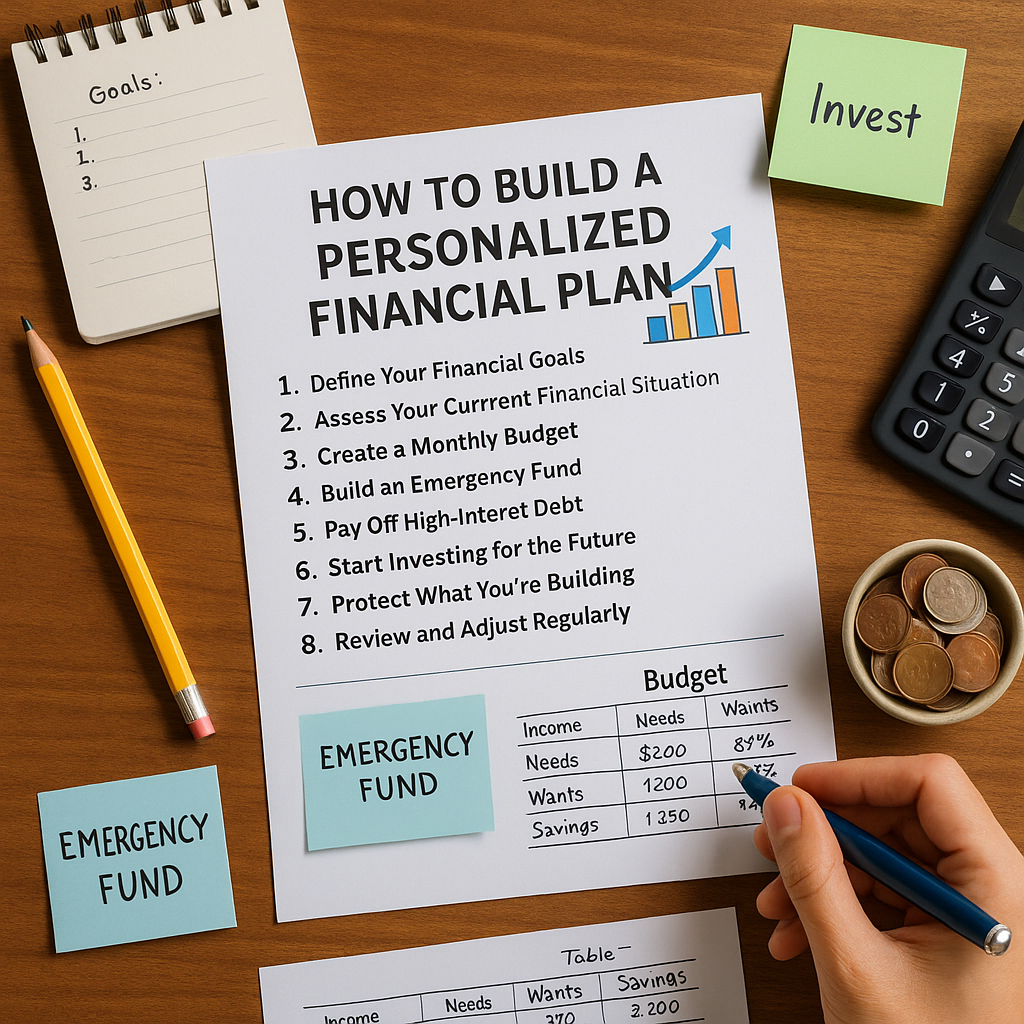If you want to take control of your money and reach your goals faster, you need more than good intentions—you need a financial plan. Think of it as a roadmap that guides your daily decisions and long-term strategies.
Don’t worry—you don’t need a financial advisor or fancy tools. In this article, you’ll learn how to build a simple, personalized financial plan that fits your lifestyle and evolves with you.
Why You Need a Financial Plan
A good plan helps you:
- Clarify your money goals
- Prioritize your spending
- Save more and spend wisely
- Reduce financial stress
- Prepare for the unexpected
- Stay focused on long-term progress
Without a plan, it’s easy to drift, overspend, or lose sight of what really matters.
Step 1: Define Your Financial Goals
Start by writing down 3–5 goals that reflect what you want your money to do for you.
Examples:
- Pay off $5,000 in credit card debt
- Save $10,000 for a home down payment
- Build a 6-month emergency fund
- Start investing $200/month for retirement
- Take a vacation without using credit
Make your goals SMART: Specific, Measurable, Achievable, Relevant, Time-bound.
Step 2: Assess Your Current Financial Situation
Get a clear picture of where you stand today.
Gather:
- Monthly income (after tax)
- Fixed expenses (rent, loans, insurance)
- Variable expenses (groceries, fuel, dining out)
- Debts (balances + interest rates)
- Current savings and investments
Calculate your net worth:
Assets – Liabilities = Net Worth
This will show your starting point.
Step 3: Create a Monthly Budget
Your budget is the foundation of your plan.
Choose a method:
- 50/30/20 Rule
- Zero-based budgeting
- Envelope method
- App-based tools (YNAB, Mint, Goodbudget)
Make sure you include:
- Needs (50%)
- Wants (30%)
- Financial goals (20% or more if possible)
Track your spending and adjust monthly.
Step 4: Build an Emergency Fund
Before you invest heavily or pay off all debt, build a safety net.
Emergency Fund Basics:
- Start with $500–$1,000
- Grow to 3–6 months of expenses over time
- Keep it in a high-yield savings account
- Use only for real emergencies (job loss, car repair, medical bills)
This gives you peace of mind and prevents debt in a crisis.
Step 5: Pay Off High-Interest Debt
Debt eats into your future. Make a plan to eliminate it.
Use either:
- Snowball Method: pay off smallest debts first
- Avalanche Method: pay off highest-interest debts first
Pay more than the minimums and avoid taking on new consumer debt.
Step 6: Start Investing for the Future
Once you have a small emergency fund and a handle on debt, start investing—even small amounts.
Focus on:
- Employer 401(k) (especially if there’s a match)
- Roth IRA or Traditional IRA
- Low-cost index funds or ETFs
- Robo-advisors for automation
The earlier you start, the more compound interest works in your favor.
Step 7: Protect What You’re Building
Your financial plan should include protection against setbacks.
Important areas:
- Health insurance
- Renters or homeowners insurance
- Disability insurance
- Life insurance (especially if you have dependents)
Also, consider creating a basic will or estate plan.
Step 8: Review and Adjust Regularly
Life changes—and so should your financial plan.
Review every 3–6 months:
- Are you hitting your savings targets?
- Have your goals changed?
- Are there new income or expenses to plan for?
- Is your budget still working for your lifestyle?
Stay flexible and committed.
Final Thoughts: You Don’t Need to Be Perfect—Just Consistent
You don’t have to know everything about money. You just need a simple, personal plan—and the discipline to follow it step by step.
Start where you are. Use what you have. And remember: every dollar you manage with intention moves you closer to the life you want.


Sem comentários